
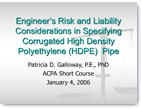 |
Risk and Liability by Pat Galloway, Former ASCE President This bulletin is in a PowerPoint format. Should you Specify Flexible Pipe? As long as you understand the facts, the risks and liabilities associated with the engineering decisions that you make and the design that you prepare, review and/or approve.
|
||||
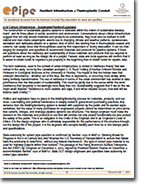 |
Resilient Infrastructure ≠ Thermoplastic Conduit |
||||
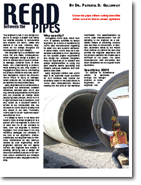 |
“Read Between the Pipes” by Dr. Patricia D. Galloway Fall 2006: Roads & Bridges Stormwater Supplement |
||||
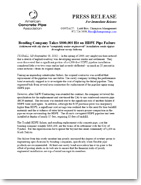 |
Bonding Company Takes $800,000 Hit on HDPE Pipe Failure (PressRelease) The Tyndall HDPE failure, and resulting replacement with concrete pipe, cost the bonding company roughly $800,000, per the terms of its settlement with the City of Tyndall. But the repercussions have spread far beyond this small community of 1,100 in South Dakota. |
||||
Court Cases Due to Failure |
|||||
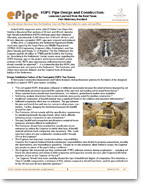 |
HDPE Pipe Design and Construction:Lessons Learned from the East Texas Fish Hatchery Incident Resource # e-011 In April 2009, inspectors at the John D. Parker East Texas Fish Hatchery discovered that sections of high-density polyethylene (HDPE) drainage pipes had collapsed. In a Compromise and Settlement Agreement HDR Engineering, Allco, and Travelers Casualty and Surety Co. of America, the Engineer paid $3.18 million to TPWD and $213,000 to the Contractor. It is noteworthy that the HDPE pipe manufacturer was not a party to the Settlement. |
||||
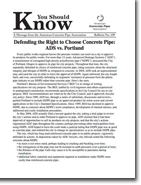 |
“Defending the Right to Choose Concrete Pipe: ADS vs. Portland” (YSK Bulletin #139) February, 2006 Every public works engineer knows the pressure vendors can exert on a city to approve its products for public works. For more than 15 years, Advanced Drainage Systems (“ADS”), a manufacturer of corrugated high density polyethylene pipe (“HDPE”), pressured the City of Portland, Oregon to approve its pipe for city projects. Throughout that time, the city repeatedly defended its choice of reinforced concrete pipe, citing concerns about the structural integrity and lifespan of HDPE as compared to concrete. In 2004, ADS took an unprecedented step, and sued the city in order to force the approval of HDPE. In 2005, ADS appealed and lost again. The city successfully defended its engineers’ right to choose—and it chose reinforced concrete pipe. |
||||
Shell Lake, WI: |
|||||
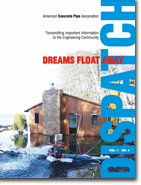 |
Dreams Float Away — Drainage Pipe Selection Deprives Residents of Money and More Dispatch — Volume 1, Number 4 Dear Editor, My parents purchased our cabin on Rolph’s Point just about 30 years ago and I grew up spending summers at Shell Lake. The first weekend of October 2002, we lost the battle. Eight inches of water in the cabin resulted in buckled floors, water soaked insulation, and broken sheetrock, in addition to mold, frogs and filth…If the focus was on the people affected and the community benefit realized by and from these community members, would there be more productive action toward getting the lake level problem resolved? |
||||
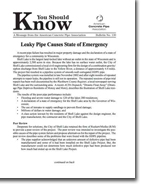 |
“Leaky Pipe Causes State of Emergency” (YSK Bulletin #130) October, 2003 A recent pipe failure has resulted in major property damage and the declaration of a state of emergency for a community in Wisconsin. |
||||
Ridgeline in WV: |
|||||
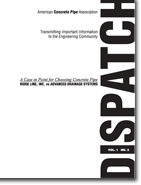 |
A Case in Point for Choosing Concrete Pipe — Ridge Line, Inc. vs. Advanced Drainage Systems Dispatch — Volume 1, Number 3 The case of Ridge Line, Inc. vs. Advanced Drainage Systems (ADS), Case No. 2:00 – 1056, in the U.S. District Court of West Virginia is a good example of what the limitations are for HDPE drainage pipe, and how problems resulting from these limitations are addressed when brought to the attention of the HDPE pipe manufacturer. |
||||
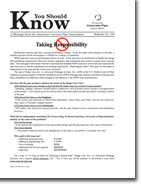 |
“Taking Responsibility” (YSK Bulletin #129) August, 2003 The case of Ridge Line, Inc. vs. Advanced Drainage Systems, Inc. (ADS) in the U.S. District Court of West Virginia is a good example of what the limitations are for HDPE drainage pipe, and how problems resulting from these limitations are addressed when brought to the attention of the HDPE pipe manufacturer. |
||||
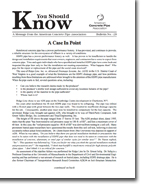 |
“A Case in Point” (YSK Bulletin #128) August, 2003 Reinforced concrete pipe has a proven performance history. It has provided, and continues to provide, a reliable structure for the conveyance of effluent in a variety of conditions. HDPE pipe has a proven performance history as well. It has proven to be insufficient to handle the design and installation requirements that most owners, engineers, and contractors have come to expect from concrete pipe. Time and again individuals who have specified and installed HDPE pipe have come back and inspected the pipe later only to find the installation not meeting expectations. What happens then? |
||||
Toledo Zoo |
|||||
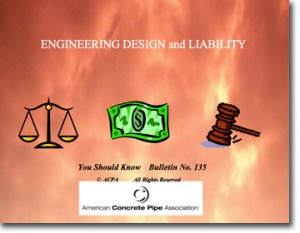 |
“Engineering Design and Liability” (YSK Bulletin #135) February, 2006 This bulletin is in a PowerPoint format. It illustrates the differences in performance between reinforced concrete pipe and high density polyethylene pipe (HDPE) and emphasizes the potential liability the consulting engineer assumes when selecting pipe materials for storm drainage applications. This presentation looks at the Toledo Zoo expansion project as an example. |
||||
Bonding Company |
|||||
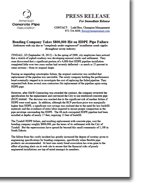 |
Bonding Company Takes $800,000 Hit on HDPE Pipe Failure (PressRelease) TYNDALL, SD (September 18, 2012) – In the spring of 2009, city employees here noticed that a stretch of asphalt roadway was developing unusual cracks and settlement. They soon discovered that a significant portion of a 4,000-foot HDPE pipeline installation completed little over two years earlier had severely deflected – as much as 25 percent in some sections – from its original shape. |
||||
Legislature |
|||||
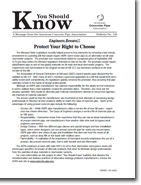 |
“Engineers Beware!! Protect Your Right to Choose” (YSK Bulletin #126) May, 2003 The Missouri State Legislature recently helped preserve free enterprise by removing a last-minute amendment to a pending bill that would require HDPE storm sewer pipe as an alternative on all state stormwater projects. The provision was mysteriously added to a proposed piece of legislation (HB 327) just days before the Missouri legislature intended to vote on the bill. The provision would require polyethylene pipe as one of two piping materials on all state and local stormwater projects. The requirement was not included in the original version of HB 327, but somehow surfaced in the final version of the bill. |
||||
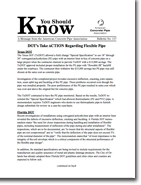 |
“DOT’s Take Action Regarding Flexible Pipe” (YSK Bulletin #117) December, 1999 This You Should Know bulletin provides information on recent actions taken by certain State Departments of Transportation regarding the acceptance, specification and use of flexible pipe products, including HDPE, PVC and CMP. The bulletin contains information on actions by the sates of Texas, Florida and Illinois. Many other State DOT’s have also taken action or are currently considering actions. The evidence suggests that State DOT’s are becoming more concerned about the continued use of flexible pipe products under roadways and other applications. |
||||
Deflection Failure |
|||||
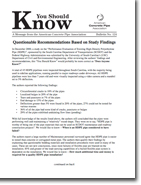 |
“Questionable Recommendations Based on Study Findings” (YSK Bulletin #124) December, 2002 In December 2000, a study on the “Performance Evaluation of Existing High-Density Polyethylene Pipe (HDPE)”, sponsored by the South Carolina Department of Transportation (SCDOT) and the Federal Highway Administration was submitted by the University of South Carolina’s (USC) Department of Civil and Environmental Engineering. After reviewing the authors’ findings and recommendations, this “You Should Know” would probably be more correct as “Does Anyone Know?” |
||||
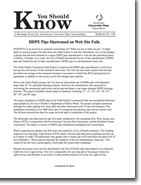 |
“HDPE Pipe Showcased on Web Site Fails” (YSK Bulletin #120) October, 2001 The City of Pueblo in Colorado has banned the use of a manufacturer’s HDPE pipe and has limited the use of other manufacturer’s HDPE due to an alarming discovery while inspecting installed HDPE pipe. An inspection of a section of 4800 linear foot of corrugated polyethylene pipe showed deflections up to 8% and quite a bit of soil infiltration. The failure at North Pueblo Commercial Park demonstrates how a municipality or agency that is cautious in allowing alternate pipe materials can still suffer damages. |
||||
Flammability |
|||||
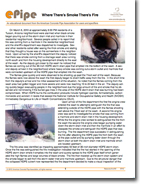 |
Where There’s Smoke There’s Fire Resource #e-016 Plastic melts and burns, this resource shows 2 very real examples of the problems with plastic pipe in areas where natural and man-made fires can exist. |
||||
Polypropylene |
|||||
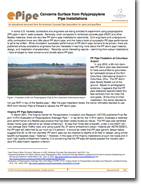 |
Concerns Surface from Polypropylene Pipe Installations Resource #e-018 In some U.S. markets, contractors and engineers are being solicited to experiment using polypropylene (PP) pipe in storm water projects. Recently, some interesting reports – stemming from actual installations – have emerged to raise concerns and doubts about PP pipe. |
||||
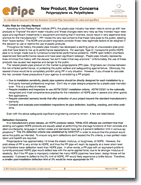 |
New Product, More Concerns – Polypropylene vs. Polyethylene Resource #e-009 Throughout its history, the plastic pipe industry has developed a startling array of unsuccessful pipe products that have failed to live up to performance expectations. PPI mocks the very real concerns that these risks pose to the public, labeling them “scare tactics.” The ACPA and prudent engineers consider those risks legitimate factors to be weighed in the decision to use or restrict the use of plastic products. |
||||
Durability |
|||||
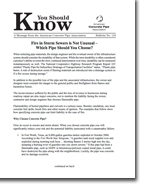 |
“Fire in Storm Sewers is Not Unusual – Which Pipe Should You Choose?” (YSK Bulletin #119) October, 2001 When selecting pipe materials, the design engineer and owner should consider the durability of the system. Durability can also be determined from the ability of the pipe to resist fire. Flammability of buried pipelines and culverts is a serious issue. In addition to excellent case histories, this bulletin discusses the risk and liability that is inherent when one chooses flammable pipe. |
||||
Other |
|||||
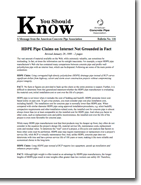 |
“HDPE Pipe Claims on Internet Not Grounded in Fact” (YSK Bulletin #116) Revised January, 1999 The vast amount of material available on the Web, while extremely valuable, can sometimes be misleading. In fact, at times the information can be outright inaccurate. For example, a major HDPE pipe manufacturer’s Web site has contained many comparisons between concrete pipe and profile wall polyethylene pipe with an interior liner, which can be disputed. Check out the claims and decide for yourself. |
||||
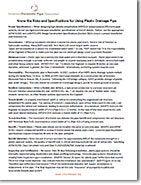 |
Know the Risks and Specifications for Using Plastic Drainage Pipe A comprehensive list of reference specifications and considerations for plastic pipe when determining the best drainage solutions. |
||||